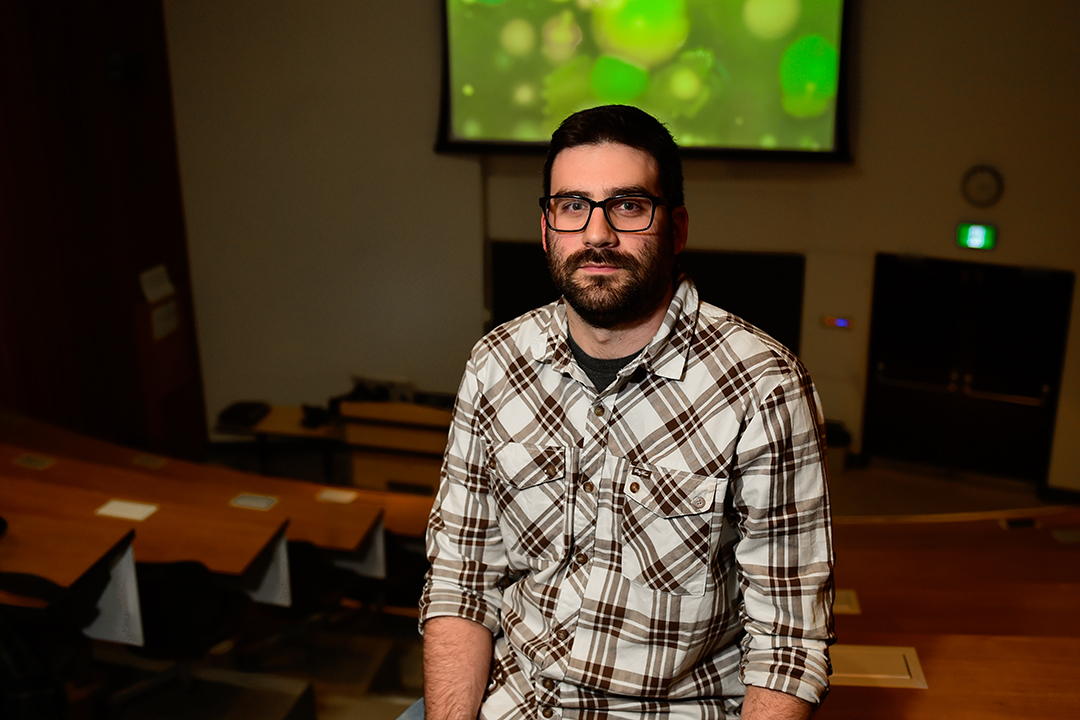
Scientist searches for best behaviour in bacteria
What do a colony of fungus-farming ants and a herd of milk-producing cows have in common? In Tony Ruzzini’s eyes, both have much to teach us about the behaviour of bacteria — and how it may be turned to good use.
By Kathy FitzpatrickRuzzini, who describes himself as a “molecule person,” joined the Western College of Veterinary Medicine’s Department of Veterinary Microbiology as an assistant professor in November 2017. Before moving to Saskatoon, he completed postdoctoral fellowships at University of Paris-Sud and Harvard Medical School.
Driven by inborn curiosity, Ruzzini gravitated to protein chemistry and molecular biology at Trent University in Peterborough, Ont., where he obtained his Bachelor of Science degree. He earned his PhD degree in that same field at the University of British Columbia, where he studied mechanistic enzymology (how enzymes work at the molecular level). He focused on bacterial enzymes that help break down polychlorinated biphenyl (PCB) metabolites — research with potential application for cleaning up toxic pollution.
As he neared the end of his PhD program, Ruzzini’s interest in antibiotics grew. In France he spent five months studying Streptomyces (the largest genus of antibiotic-producing bacteria) at a molecular microbiology genetics lab “just to sort of get my feet wet,” he explains.
That was the stepping stone to a natural products chemistry lab at Harvard Medical School. The lab’s focus on exploring the biological function of molecules appealed to Ruzzini, whose own interest lies in looking for what naturally occurs in the environment rather than creating synthetic chemicals.
“If we consider the application, then I’m trying to find a drug — not make one,” he says.
In one project, Ruzzini looked at bacterial symbiosis in one species of ants. These ants grow a specific fungus cultivar, collecting leaf and plant material to feed their crop. However, as with gardens everywhere, there are pests in the environment; in this case, parasitic fungi are the culprits.
Scientists believe the ants carry antibiotic-producing bacteria on their exoskeletons, which serve as a defence. Ruzzini and his colleagues at Harvard Medical School were investigating which antibiotics (or small molecules) those bacteria produce, and their effects.
As well, the research team looked for the responsible genes or biosynthetic gene clusters. Using single or multi-gene sequencing, all bacteria appeared indistinguishable — but they produced very different antibiotic compounds. The reason, Ruzzini explains, is that each bacterium hosts different plasmids (extra pieces of DNA).
The ant project was the first time anyone had discovered that plasmids in a collection of closely-related bacteria generated “a ton of chemical diversity.” In turn, that process can change how bacteria behave.
The practical application here is finding new drug leads or new small molecules with potential therapeutic uses, Ruzzini says. In some ways, he explains, the threat to the ant colony’s slow-growing fungal cultivar by the fast-growing parasitic fungus resembles cancer. And indeed, a lot of early chemotherapy drugs are bacterial small molecules.
“Bacterial small molecules have certainly been invaluable to medicine, outside of just being anti-bacterials or anti-fungals,” says Ruzzini.
The research team also found that the ant-inhabiting bacteria produce molecules that beat off other bacteria — a kind of niche competition.
As a long-term research goal, Ruzzini wants to study the evolution of the molecules that bacteria produce. Attempting to understand how these small molecules evolved may help to design future experiments. Scientists have much to learn from studies of how bacteria — the first inhabitants of Earth — have changed their molecules over time.
In one of Ruzzini’s first projects at the WCVM, he will explore why some dairy cows develop mastitis (inflammation of the mammary gland) while most of their herd mates do not. Differences between bacteria found on the teats of healthy and infected cows may provide answers if they lead to a molecule that provides protection.
Saskatchewan’s Agriculture Development Fund is supporting the mastitis project while the Saskatchewan Health Research Foundation is funding a genetic examination of plasmids from bacteria associated with livestock and companion animals. In this study, Ruzzini will try to move any antibiotic-producing plasmids to a model organism in the lab and see if he can use them to produce the molecules of interest. And since plasmids are exchanged by bacteria, he’ll also investigate those passed from organisms in animals to those in human beings, possibly setting the stage for the transmission of disease.
“Having a catalogue of plasmid-encoded genes and specifically those that are involved in antibiotic production or virulence determination would be tremendously insightful,” he says.
Ruzzini confesses his surprise at becoming a WCVM faculty member, describing himself as “not a conventional hire for the college.” Happily, he has found that people are receptive to his research interests and approach, and he’s excited by the prospect of multi-disciplinary collaboration at the WCVM and across campus. The WCVM provides an ideal environment for his new focus on the microbiomes of animals, and he sees potential in using the synchrotron as a useful tool for studying protein-small molecule complexes.
Ruzzini “brings to us a whole set of approaches and tools that we don’t currently have here,” says Janet Hill, head of the WCVM’s Department of Veterinary Microbiology. She adds that “… his interest in the interaction of microbes with the host is so central to so many of the things that we do” in terms of infectious disease and animal health promotion.
Hill sees the benefit of Ruzzini interacting with veterinarians and people who work in the field directly with animals: “That’s where a lot of the really good questions come from.”
Kathy Fitzpatrick is a freelance journalist in Saskatoon. Born in Manitoba, she has spent close to four decades working in media — including radio, television, print and digital.